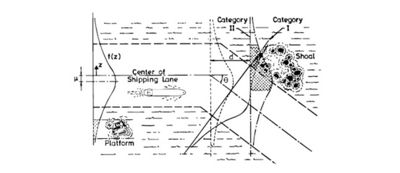Lateral Traffic Distribution
The Lateral Traffic Distribution transversal to a route is a strong function of the waterway in question, so one of the major challenges of the present approach is to properly model this distribution along a given route.
Figure 11 Illustration of model for predicting the expected number of grounding events or collisions with fixed objects on a given ship route, from [25].
The Lateral Traffic Distribution (LTD) must be modelled for each leg of each route within the area being analysed.
The IWRAP programme is capable of modelling complex LTD´s.
Modelling LTD with AIS Data
With access to AIS data it is a relative straight forward task to assess the probability distribution of the traffic spread across the route as well as the number and the composition of the vessel traffic. With the aid of proper statistical AIS tools, the LTD can readily be extracted from the AIS data.
The free IALA version of IWRAP does not include any AIS extraction functions however Gatehouse has planned to make available a commercial extension to IWRAP, which automates the extraction of LTD´s fro AIS data.
Modelling LTD without AIS Data
When AIS or similar data are not available it is quitehard to properly model the LTD.
Only little guidance has been found in literature on the geometric distribution of the traffic. Typically a normal distribution is selected. Gluver and Olsen [12] proposed to apply a standard deviation equal to ship length. Alternatively the standard deviation of the Gaussian distribution can be selected to be proportional to the vessel breadth,σ = 3,65B. This choice corresponds to a 96% probability of the vessel being within ± 7.5B of the planned route, which again reflects the zone within which the navigator of the vessel identifies safe operation.
In the study by Karlson et al. [19] the standard deviation of the Gaussian distribution was chosen to 40% of the navigational channel.
|
Source: IWRAP Mk II, Basic Modelling Principles for Prediction of Collision and Grounding Frequencies, (draft working document), Rev. 4, 2008.03.09, Peter Friis-Hansen, Technical University of Denmark. |
